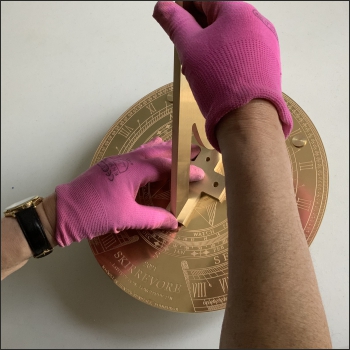
Details for making the sundial came from archive records and photos. This image shows the design and successful first assembly of the new parts.
The replica of a 19th century lighthouse sundial we are making will be part of a mobile exhibition. It is progressing well. Lighthouse sundials were made by skilled instrument makers, who worked mainly with hand tools. We are using modern techniques for cutting out the metal and etching the intricate design on the dial plate. The picture shows our first trial to assemble the dial and gnomon parts.
There is always the question of whether a modern replica should be the same as the original object. Modern processes are invariably different from an original. They do offer control and accuracy, but they can lose the artistry of work done by hand. However, by careful judgement it is possible to get very close using modern techniques, and this was our aim.
A sundial is a mathematical instrument that once had an important function to set the time for the lighthouse clocks. It needed to be accurate so the lighthouse keepers could carry out their duties. We have kept this function of an accurate instrument as our main priority for the new replica.
The construction of the replica follows the original. Exact profiles have been cut by water jet and laser, and the surface finish is like historical examples. The style and appearance of original hand engraving for the letters and numerals on the dial are hard to match exactly, but with the help of thoughtful graphic design and advanced photoetching it is still possible to achieve a pleasing result. We hope the sundial replica will be a success.
